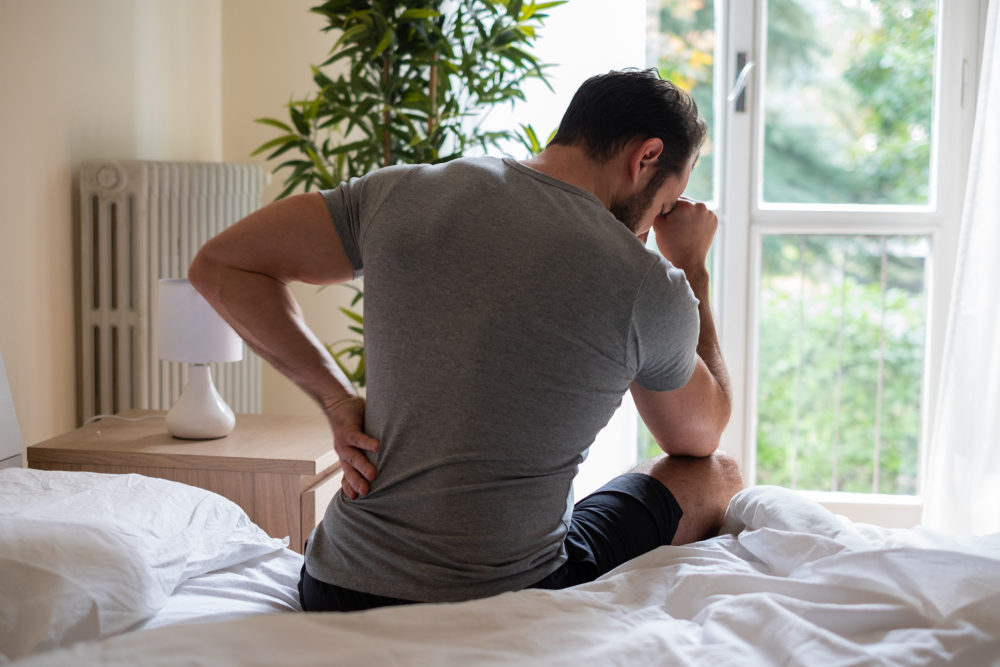A herniated disc can make going about your everyday life extremely painful. Here are some tips to help you get relief.
If you’ve been diagnosed with a herniated disc, your first question to your orthopedic specialist will likely be, “How can I reduce the pain?” Things you once took for granted like sitting at a desk and getting a good night’s sleep now seem more challenging or entirely out of reach.
A herniated disc is a common orthopedic injury, but it can be very disruptive to living a full and active life. It occurs when one of the gel-filled discs that acts as a shock absorber between the vertebrae in the spine ruptures or slips out of place. The damaged disc then irritates the nearby nerves, causing uncomfortable and painful symptoms.
Fortunately, herniated discs often respond well to physical therapy and pain medication and rarely require surgery. As part of your recovery, your physical therapist will show you the best ways to sit and sleep in order to reduce the pain.
How to Sit and Sleep With a Herniated Disc
A herniated disc can happen anywhere along the spine, from the neck to the lower back, and is usually the result of aging or something as simple as a forceful sneeze, lifting a heavy object, or sleeping in an awkward position. If the herniated disc doesn’t touch a nerve, you won’t experience any symptoms. But if it does, you’ll likely feel pain radiating along the buttocks, legs, and feet. Tingling, numbness, and a feeling of weakness can also accompany a herniated disc.
When you sit or lie down to sleep, the pain can be intense. However, properly aligning your spine can ease the pressure on your back and significantly reduce your discomfort. Your orthopedist and physical therapist will model the best sitting and sleeping positions, but here are some general tips to make sitting and sleeping less painful.
Sitting. Sitting for long periods of time isn’t ideal for people with a herniated disc. A standing desk is a great option, but if you must sit, rest your spine firmly against the chair back, sit up straight, and don’t slouch (which strains the spinal ligaments and aggravates a herniated disc). Your knees should be level with your hips, or slightly above the hips if you’re seated at a desk. The chair should be at a height that allows you to keep your feet flat on the floor.
To provide extra support, wedge a rolled-up towel or small pillow between the chair and the arch of your lower back. This also works when you’re in your car. If you do have to sit for a long period of time, be sure to take frequent breaks to stretch your muscles.
Sleeping. It’s hard to get a good night’s rest when your back is aching. But you can sleep comfortably if you know the right positions. Sleeping on your stomach is not a great option because it shifts the natural curve of the spine out of alignment and puts pressure on your back and neck. If you must sleep on your stomach, put a pillow under your hips and knees to maintain the proper curvature of the spine and relieve the pressure on the herniated disc.
Better alternatives are sleeping on your side or back. Side-sleepers can place a pillow between the knees to relieve any stress in the hips, or elevate their legs on a pillow. You can also slip a rolled-up towel between your waist and the mattress as you sleep on your side. And always lie on the side where you don’t feel any pain.
The optimal sleeping position for a herniated disc is on your back. Lying on your back keeps your spine in a neutral position so you have less chance of pinching the nerve. For added comfort, nestle a small pillow or rolled-up towel under your knees and lower back. A wedge-shaped pillow that raises your legs and ankles may also lighten the pressure on the herniated disc.
Get Relief from Back Pain
If you’re suffering from an aching back, the specialists at New York Bone & Joint can diagnose and treat your pain, whether it’s due to a herniated disc or another orthopedic condition. Once you’ve identified the source of your pain, our doctors and physical therapists will help minimize your discomfort with proper treatment. Contact us at New York Bone & Joint today to set up a consultation.




